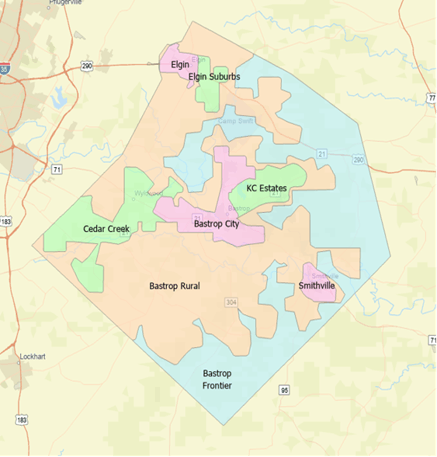Operational Performance Standards
Response Time Compliance
Response time compliance intervals have been established by the Bastrop County ESD #3 Board of Commissioners to promote equitable access to timely care in certain emergency situations. Response times are measured for each Priority 1 (Life Threatening) and Priority 2 (Potentially Life Threatening) calls. The District reviews performance on a monthly basis and works closely with Acadian to make dynamic adjustments to the ambulance deployment to optimize service delivery.
The District worked closely with the Bastrop County GIS Department to establish a population density tiers. These tiers are set gradations with associated response time expectations based on population density. The Population Density Tiers are:
Urban
- the boundaries of a municipality including Bastrop, Elgin, and Smithville; or
- a population >=1,300 people in 1.0mi x 1.0 mi area
Suburban
- a population between 500 people and 1,299 people in a 1.0mi x 1.0mi area
Rural
- a population between 50 people and 499 people in a 1.0mi x 1.0mi area
Frontier
- a population range of 0 people and 49 people in a 1.0mi x 1.0mi area
The District and Acadian will review the Population Density Tiers on an annual basis and make changes as necessary.
The response time expectation by tier is shown below for Priority 1 and Priority 2 calls. Penalties may be imposed if the response time compliance for any tier falls below 90%.
| Priority 1 (Life Threatening) | Priority 2 (Potentially Life Threatening) | |
|---|---|---|
| Urban | 9:59 | 11:59 |
| Suburban | 11:59 | 13:59 |
| Rural | 13:59 | 15:59 |
| Frontier | 15:59 | 18:59 |
Compliance Calculation
Overall and Population Density Tier compliance metrics are calculated from data generated by dispatch operations and field operations.
Under this Agreement, response time compliance will be tracked and monitored for Priority I and Priority 2 calls only. However, in determining compliance all dispatched emergency calls (Priority 1, 2, 3, 5 or 32) will be tracked to calculate call volume as it relates to exemptions for High Demand. Non-emergency transfers (i.e. inter-facility transfers) will not be used in the determination of High Demand.
Response Time Calculation
The response for each call is calculated from the time the dispatcher confirms the address and nature of the call to the time the ambulance arrives on scene.
Response Time Exemptions
From time to time, unusual factors beyond Acadian's reasonable control may affect the achievement of specified response time standards. These calls may be exempted from the monthly compliance reporting after review by the District. Such circumstances include:
a. Severe Weather Requests occurring during a period of unusually severe inclement weather conditions when such response time compliance was either impossible or achievable only at great risk to Provider personnel and the public. Such conditions include but are not limited to situations that impede visibility (i.e. torrential rain, near visibility fog), extreme winds, and flooding. Delays due to weather should be reported to the dispatcher and documented in Acadian’s CAD notes for the call. Acadian shall provide CAD documentation for any weather exemption requests.
b. Multiple Units on Scene In the event of multi-unit unit response, response time calculation to the call shall be determined by the first arriving Ambulance unit. All other responding units are exempt.
c. Wrong Information Situations where the Acadian Communications Center received false or inaccurate information or was unable to obtain adequate information from the caller to make an accurate response. Such situations may result in a response delay or a unit being dispatched to the wrong location.
d. Declared Disaster Requests during the response period of a declared disaster within Bastrop County as determined by the County Judge, during which Acadian rendered assistance. During such periods, Acadian shall use best efforts to maintain primary coverage, while simultaneously providing disaster assistance as needed.
e. High Demand Requests during times of unusually heavy call demand, defined as those times when, considering all Emergency Calls (Priority 1, 2, 3, or 5), the number of emergency response requests District–wide within a one (1) hour period exceeded five calls.
f. Impassable Roadway In the event the Ambulance response was delayed or caused to reroute due to an impassable roadway (i.e. roadway blocked by train, flooding, traffic accident with all lanes closed, etc.), and there was no reasonable alternative route.

